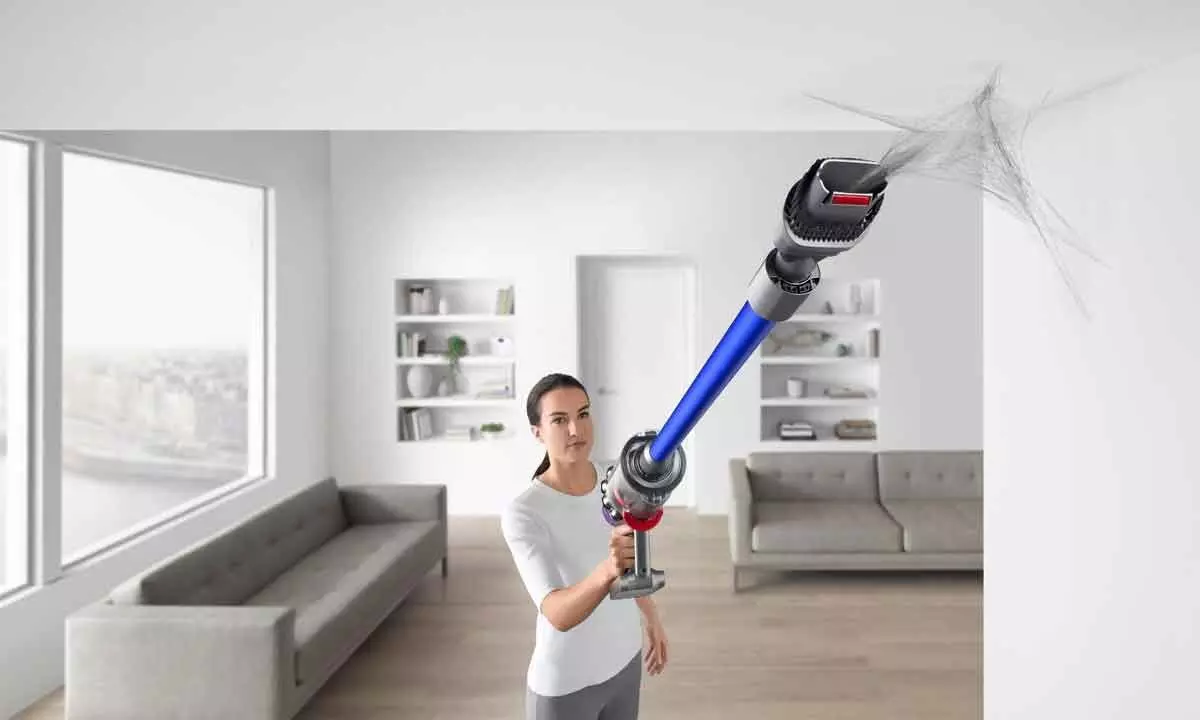Dyson reveals the most neglected spots during cleaning

According to the Dyson Global Dust Study 20221, 46% of Indians have significantly increased their frequency of cleaning, and 2 in 3 Indians clean their homes 5-7 times a week, the most frequent in the entire Asia Pacific region.
Indians are one of the most obsessed with cleaning the spaces where we spend time. According to the Dyson Global Dust Study 20221, 46% of Indians have significantly increased their frequency of cleaning, and 2 in 3 Indians clean their homes 5-7 times a week, the most frequent in the entire Asia Pacific region. While dust is seemingly innocuous, in reality, it is a complex matrix of components, including dust mites, dust mites' faeces, bacteria, small insects, and other particles. While most people vacuumed their floors regularly, other spaces such as mattresses, walls, ceilings, etc were commonly overlooked. Dennis Mathews, Research Scientist in Microbiology at Dyson, reveals some of the most neglected spots people overlook when cleaning their homes and shares tips to deep clean your home.
Take a minute and think that the clean spaces we see are actually clean enough? Is some dirt that can still be sitting there that is not visible to the naked eye? Have you covered areas that could still be a hotspot for dust after you are done with a thorough cleaning regime? 7 in 10 homes have at least one dust-allergy sufferer, yet 40% of Indians still think household dust is relatively harmless, revealed the study. Oftentimes, we forget the fine dust that may be sitting there and the potential impact that it could have on our health. While dust is seemingly innocuous, in reality, it is a complex matrix of components, including dust mites, dust mites' faeces, bacteria, small insects, and other particles. Hidden to the naked eye, they are widely spread on various surfaces of your home, including floors, sofas, and beds.
A simple action such as sitting on a sofa causes particles to float in the air and can trigger an allergic reaction. We roughly spend one-third of our lives in our beds 2 , but the Dyson Global Dust Study 2022 1 shows that Indians hardly prioritise cleaning their mattresses. It may look clean, but it can be a hotbed for millions of dust mites, impacting your well-being while you sleep. While most people vacuumed their floors regularly, other spaces were commonly overlooked, such as mattresses, walls, ceilings etc. Dennis Mathews, Research Scientist in Microbiology at Dyson, reveals some of the most neglected spots people overlook when cleaning their homes and shares tips to deep clean your home.
He says, "It is common to clean dust visible to the eye; however, there are certain places that are easily overlooked. Dust has a negative impact on our health and wellness. Some neglected areas we often fail to notice contain fine dust, which is a key contributor to health issues, therefore it is essential to identify these spots and remove all dust even microscopic in size to ensure a clean and healthy home"
To make your cleaning ritual really effective, keep a look out for the most neglected spaces mentioned below:
1. Walls
Cleaning of walls is something we hardly consider. According to Dyson Global Dust Study 2022 1 , only 32% of Indians clean walls as a part of their regular cleaning. However, dust on certain wall types can contribute to the growth of mould. Remove dust from walls by dusting with a damp cloth, cleaning wipes or using a vacuum with advanced filtration. If you're vacuuming both the ceiling and the walls, start with the ceiling followed by the walls so that you capture any airborne dust that may land on the walls or on furniture or the floor below. Cleaning from the top down ensures that you pick up any fallen airborne dust as you go.
2. Mattresses
Dust mites feed on skin cells, which we shed 2-3g of per day and even more at night, owing to the friction from bed linens. Therefore, mattresses can be breeding grounds for house dust mites, who thrive in warm, dark, and humid places like our beds. There can be millions of dust mites in a single mattress, and each mite produces around 20 faecal pellets a day which harbour an allergenic protein that can trigger allergic reactions.
However, 63% of Indians don't clean or vacuum their mattress regularly, as per the study. Vacuuming your mattress on both sides will help reduce the number of skin flakes and allergenic material in your mattress, and washing sheets and blankets on a 140°F or 195°F wash will help to break down and reduce allergens.
3. Pet baskets
21% of Indians are unaware that pet allergens that trigger pet-related allergies can be found in household dust and only 36% clean their pet baskets on a regular basis. Just like mattresses, pet baskets can harbour dust mites, who feast on pet dander shed by animals. If possible, launder any removable covers on a 140°F or 195°F wash. Where that isn't feasible, use the mini-motorised tool on a vacuum cleaner in handheld mode to agitate and "peel off" any unwanted pet hair, dander and allergens.
4. Lamps and lampshades
Dust can gather in lampshades and light fittings, however, 73% Indians neglect cleaning them according to the study 1 . Using the soft brush attachment of your vacuum cleaner with an up-top adaptor will help reach high lampshades.
5. Shelves
55% of Indians don't clean their shelves regularly 1 which is no surprise as cleaning shelves can be a tedious task. For a deeper clean, start by carefully removing the contents of your shelves. Vacuum the top shelves first so that you don't miss any airborne dust that might settle further down. Use the soft brush attachment on your vacuum cleaner with an up-top adapter to remove dust from high-up areas. Using a damp cloth, gently remove any marks or stains and allow time to dry before putting the contents of the shelves back. If possible, don't forget to pull out the shelves from the wall and vacuum underneath furniture – if you can see dust, it's likely that bacteria, moulds and colonies of dust mites could already be thriving there.
6. Ceilings
Ceiling textures can harbour dust and cobwebs, but it is still neglected by 65% of Indians while cleaning their house 1 . Vacuuming is often the easiest way to clean them. Use the soft brush attachment on your vacuum cleaner to clean a larger expanse without damaging any paint or wallpaper, and opt for a crevice tool to reach hard-to-reach corners. A lightweight cord-free vacuum is a good option to clean higher-up
spaces.
7. Curtains and blinds
According to Dyson Global Dust Study 2022, 68% of Indians neglect cleaning their curtains or blinds while cleaning their house. A lot of dust can gather in them, and dust mites can thrive in textiles. Make sure you vacuum them with a soft brush tool or launder them if possible and practical.
Top tips for a deep clean
1. Clean regularly
Dust electrostatically 'sticks' to hard floors, and the longer it sits on the floor, the more effort is required to 'peel' (or dislodge) it off the surface. Cleaning regularly makes it easier to remove dust, which applies to the whole house and not just your floors. Cleaning one spot a day (listed above) means you can achieve a whole house deep clean every month. This is a highly recommended frequency to maintain a clean home without getting overwhelmed by the daunting task of trying to deep clean your entire home at once.
2. Clean the right way
There's an inclination to reach for a damp cloth and/or wet mop to clean and kill germs around the house. However, wet cleaning with disinfectants and vacuum suction to remove fine dust are two very different jobs, and they need to work in unison to achieve a clean home. The most common mistake is mopping a dirty floor and therefore creating a more favourable habitat for dust mites and mould to grow. It's essential to remove all the dust and dirt from your floors before mopping to achieve a barefoot and genuinely clean floor.
3. Use vacuums with advanced filtration
The main purpose of vacuuming is to remove dust and dirt from your home. A vacuum with advanced filtration is essential to ensure that all the nasties in your vacuum, stay within your vacuum, rather than being expelled back into your home. Look for vacuums that come with a five-stage filtration system to achieve 99.99% per cent filtration of particles as small as 0.3 microns, which ensures that the dust you're sucking up remains trapped in your vacuum and only clean air is expelled back into your home.
4. Use the right tools
The Dyson Global Dust Study 1 reveals that Indians feel that while vacuum cleaners are the most effective in removing dust from home, just 39% of Indians use a vacuum to clean their homes. 65% use a wet mop, 67% dry cloth, 70% brush and pan and there are several others who use traditional cleaning methods for their regular cleaning.
Sweeping and dusting may make surfaces look clean, but they don't remove dust from home. What they do is agitate dust, so it becomes airborne again only to settle somewhere else in the room. There is no 'one size fits all' when it comes to cleaning your home. From the size of your home to whichever part you're cleaning, being equipped with the right vacuum and tools is key. There are several vacuums of varied sizes that have been engineered to suit every kind of cleaning need. Each vacuum comes with a variety of tools to clean different places. From the Mini motorised tool that transforms your stick vacuum into a handheld vacuum and the Mattress (Upholstery) tool, designed to remove dust and allergens from textiles to the Quick- release crevice tool that helps in reaching into the narrow gaps.














